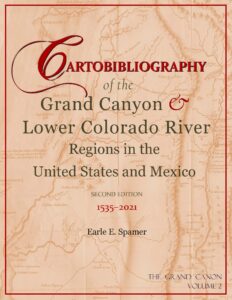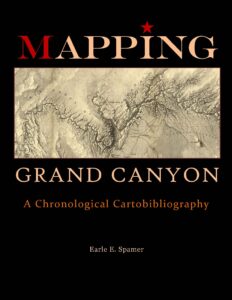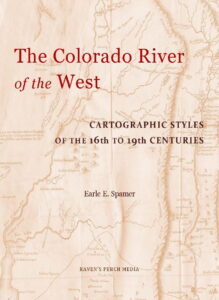
Cartobibliography of the Grand Canyon and Lower Colorado River Regions in the United States and Mexico
2ND EDITION (1535–2021) — Greatly revised and expanded
To download the Cartobibliography click on this button. (If you wish to obtain the 1st Edition, use the button farther below.)
SPECIAL NOTE: In Sections 4A and 4B of the Cartobibliography, some illustrations embedded in the PDFs that depict the system of topographic map quadrangles (which had been replicated from old-style paper copies) do not sufficiently display the quadrangle names when the PDFs are enlarged. Click on the buttons below to download high-resolution JPEG images of these maps.
ABSTRACT
The Cartobibliography is Volume 2 of The Grand Canon : A Worldwide Bibliography of the Grand Canyon and Lower Colorado River Regions in the United States and Mexico. It itemizes and often describes details on maps produced worldwide from the 16th to 21st centuries. Many citations for historical maps before the 20th century are chorographical; attention is on part of the map rather than the whole, in order to describe how the Grand Canyon and lower Colorado River regions are portrayed. Thus the principal purpose of the map may not be mentioned, such as when a map is of wider interest to cartographic historians for content that is unrelated to the physical geography of the Southwest. In some instances, remarks correct or amplify the work of earlier bibliographers. All forms of maps are listed: general, geologic and physiographic, and certain specialized maps; to which is added a complete guide to all scales of topographic map quadrangles in the greater Grand Canyon–lower Colorado River regions in the U.S. and Mexico, produced by the U.S. Geological Survey and Mexico’s Instituto Nacional de Estadística y Geografía (as also used by the Servicio Geológico Mexicano). The kinds of maps cited here vary. Many are standalone productions, while others are included in atlases or accompany reports of explorations, some of them as large fold-outs, others as maps loosely laid in or even grouped in separate covers. Maps that appear as illustrations within books and periodicals are not generally considered. Neither are manuscript maps considered, although a few significant ones are cited; those that are of seminal importance in the history of the Grand Canyon and the Southwest. Notes added to these citations provide more detailed information that describe relationships between features of physical geography, for the benefit of users who may thus determine that a map should be more closely examined, or it may suggest to them that a map is not of interest to work at hand. The Cartobibliography divides maps into two major groups: 16th–18th centuries, and 19th–21st centuries; and there is a separate, consolidated chronological list of these maps. The 16th to 18th centuries in this region recorded human interactions that focused on the lower Colorado River, by international parties with interests in the region. Only manuscript maps ventured to embrace the area that now is known to be the Grand Canyon. The 19th century saw the first sponsored explorers in three centuries spanning the region, eventually delineating the Colorado River and its tributaries correctly, discovering again the Grand Canyon. And the 20th century witnessed an explosion of general and scientific maps of the region, including topographic mapping at large scales. More specifically detailed bibliographical products and statistical surveys can be derived from this Cartobibliography.
Users who wish to obtain the 1st Edition of the Cartobibliography (2021) click on this button:
ALSO AVAILABLE

Mapping Grand Canyon: A Chronological Cartobibliography (2022)
Mapping Grand Canyon is divided into four major sections. Each concentrates on one of the principal names by which Grand Canyon was called during the past three centuries, which have appeared on maps though of course not necessarily with any degree of formality or consistency: Puerto de Bucareli (1777–1872), Big Canyon (1853–1888), Great Canyon (1853–1879), and Grand Canyon (1868–present). The citations are extracted from Cartobibliography of the Grand Canyon and Lower Colorado River Regions in the United States and Mexico (4th Edition, 2022, Volume 2 of THE GRAND CANON series). It offers up a historiographical listing specifically for the Grand Canyon country.

The Colorado River of the West: Cartographic Styles of the 16th to 19th Centuries (2023)
Everyone who has had the privilege of river-running the Colorado River knows “where it is.” That was not always the case. For years—centuries, actually—the Colorado (by whatever name it had at a given time) ran all over the place. At first, its course was simple—straight to the sea, just like that. Later, the ingenuity of cartographers, using good, awful, and “inspired” data alike, kinked, curved, and waggled the Colorado across the landscape that is the southwestern part of North America.
While their maps concentrated more on political boundaries, the locations of cities and towns, and the broad generalizations of mountains, seas and straits—done really well, or roughly portrayed, or sometimes made up, based on the “best” information of the day, or levitated straight from the works of other mapmakers so as to make some headway and a few dollars, crowns, or Louis—the tightly confined Colorado River went this way and that, picking up along the way a variety of tributary rivers and creeks (or sometimes not). It was not much of a learning process, but willy-nilly. One had to wait for boots on the ground and oars in the water to create a sensible Colorado River.
This is a cartobibliographical primer on drawing the Colorado River during the sixteenth to nineteenth centuries. It contrasts contemporary understandings of geographical relationships with current knowledge. The examples here focus on the river; how its course, tributaries, and outlet to the sea were depicted over time. In some later cases a finer focus is had on the Grand Canyon region.
Eight basic styles are identified here that describe how the Colorado River’s course was drawn across the North American Southwest, and how its mouth was depicted where the river meets the sea. For each particular style, the maps presented here are chosen from among many similar ones, without particular regard to the absolute range of years of production or publication for a given style, since maps were reused or reprinted for years without improvements to the physical geography portrayed on them. Further, it is not the purpose of this survey to produce a historiographical accounting of these styles.
This volume utilizes illustrations that focus only on the Colorado River region, from maps which otherwise encompass far broader geographies. Users even of these detailed views will surely take note of interesting points or displays that are otherwise not relevant to this survey, which always is one of the pleasures of perusing maps. Although only cropped quadrangles are usually presented, the maps are fully cited from the much more comprehensive Cartobibliography of the Grand Canyon and Lower Colorado River Regions in the United States and Mexico (Raven’s Perch Media).
Introduction
HISTORICAL NOTE: Nomenclature for Río Colorado and Colorado River
HISTORICAL NOTE: Puerto de Bucareli
HISTORICAL NOTE: The so-called “River of the Sulfurous Pyramids”
HISTORICAL NOTE: California as an Island and the Gulf of California a Strait
Basic Colorado River Course Styles—Compared
EXAMPLES
- Insular California
- Peninsular California Displaying Variant Heads of the Gulf
- Colorado River Absent
- Linear Colorado River
- Modified Linear Colorado River
- The Egloffstein Model and Variants
- Parallel Green and Grand Rivers as Colorado Tributaries
- The Colorado’s Bactrian Course Through the Grand Canyon
Appendix. Selected Early Maps of Historical Importance